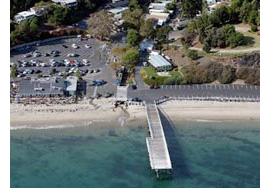Not so much trouble in Paradise (Cove)
October 29, 2009
They set out to solve one mystery, but they ended up with another.
First, the good news: An unusual three-year research partnership has found that the water quality at Malibu’s Escondido and Paradise Cove beaches is dramatically better than expected. Now the puzzling news: Nobody knows why.
“It’s like you hired Scotland Yard to solve a murder and three weeks later the dead person walks in and says, ‘Whatcha doing?’ ” says Steve Weisberg, executive director of the Southern California Coastal Water Research Project, which is running the study with $800,000 in funding from Los Angeles County. “We were hired to find the source of the problem….Where we’re at is a point of frustration.”
When the project started in May, 2006, the targeted beaches stood out as significant problem areas, according to Mark Gold, president of Heal the Bay, which has participated in the research along with the county Department of Public Works.
“Escondido was the most polluted beach we had ever seen,” Gold says. On the group’s annual Beach Report Card, he says, “I think it got a zero one year.” (Now Escondido Creek, just east of Escondido State Beach, and Paradise Cove Pier at Ramirez Canyon Creek mouth are both on the group’s honor roll.)
Back then, Gold suspected that the pollution was coming from “illegal dumping of tremendous amounts of horse manure” and maybe also from waste discharge problems from a nearby restaurant and some mobile homes.
All this added up to an opportunity for some collaborative detective work, bringing together the county and its sometime-adversary Heal the Bay, which has pushed hard for more aggressive government enforcement of clean water regulations.
The Southern California Water Research Project was “brought in as a neutral party,” Weisberg says, adding that he thought the best way to achieve a détente was to have everyone in the field “taking samples together.”
At their disposal was an array of scientific tools – including tests for optical brighteners found in laundry detergent to learn if household wastewater was involved. (For more on those, click here.) Overall, the prospects for finally determining whodunit (or whatdunit) looked good.
“The problem,” Weisberg says, “is that we just have not found strong, recurrent problems at that beach.”
One theory holds that a series of unusually dry winters led to a temporary improvement in the bacteria levels flowing from Escondido and Ramirez creeks into the bay. Another scenario posits that someone was illegally dumping, found out about the study in progress and decided to clean up his or her act. Or maybe different testing methods yield a different result? “We don’t know,” Weisberg says, “but we know it stopped.”
Weisberg says the hunt will continue in the coming year, with some discussion of testing to determine whether “birds pooping on the beach” mighty be to blame for the pollution, rather than problems in the watershed.
Gold, for his part, thinks it’s probably not worth continuing the testing effort unless there’s significantly more rainfall this year, which would bring more runoff to analyze. He does, however, advocate keeping an eye on a restaurant at the “very lowest part of the watershed.”
“You never get to pack your bags and go home,” says Gold, who praises Supervisor Zev Yaroslavsky for responding to long-running concerns about the beaches’ bacteria levels and pushing for funds to study the problem. “I’m glad we did it,” Gold says. “I think it put a lot of people’s minds at ease.”
Mark Pestrella, deputy director of water resources for the county Department of Public Works, says he also is glad the study went forward and wants to see it continue for a fourth year. “The supervisors and the constituents out there really want to know that these beaches are safe,” Pestrella says.
“The study helped us set up protocols that were not in place before….Methods of sampling, the health department’s and Heal the Bay’s, were tried side by side,” he says. “It gave us more information on the percentage of the problem we should allocate to humans. Although we didn’t actually break down every source, we eliminated several areas. In Escondido, we were able to say we did not find a human source of indicator bacteria at the beach.”
The bottom line, Pestrella says, is that the study so far has “bettered the county’s understanding of how to monitor and test for indicator bacteria. It very much put science in front of rhetoric.”













 405 bridge work causes a stink
405 bridge work causes a stink
